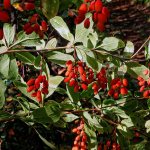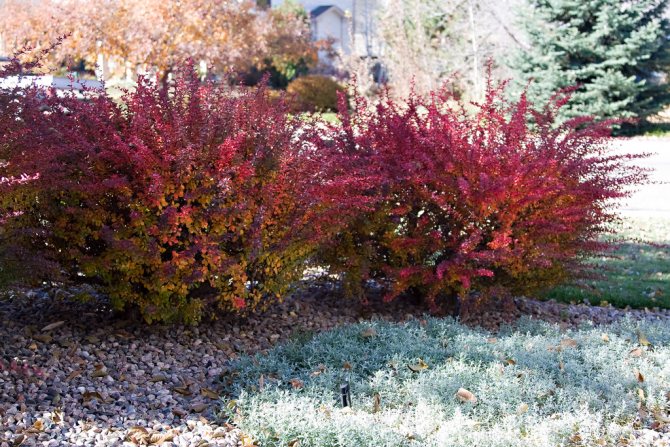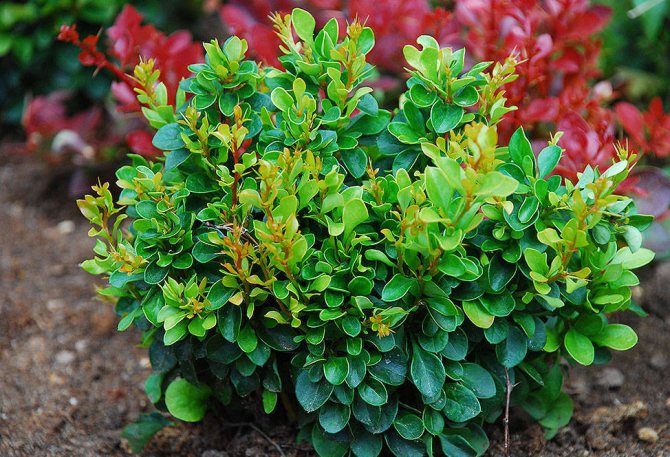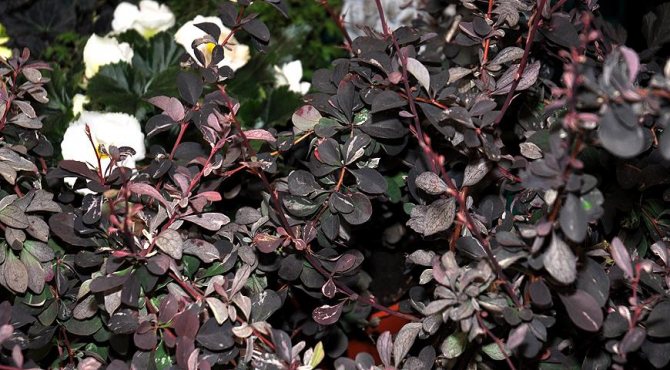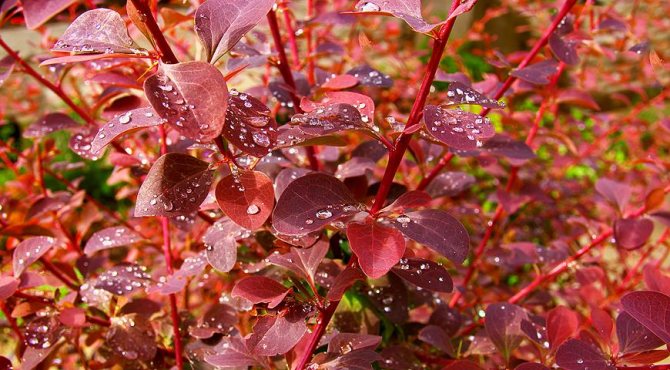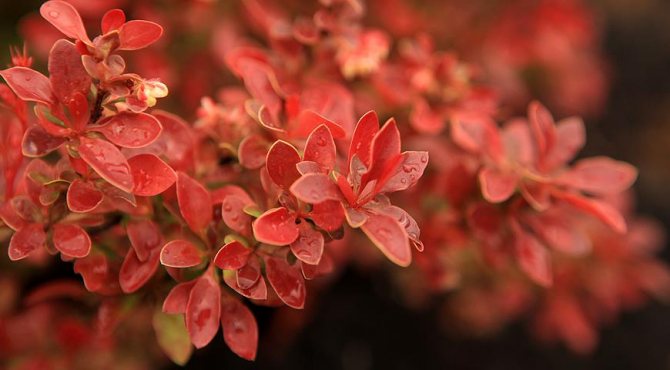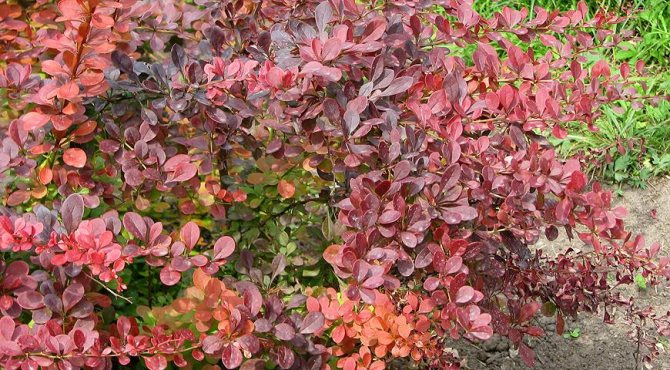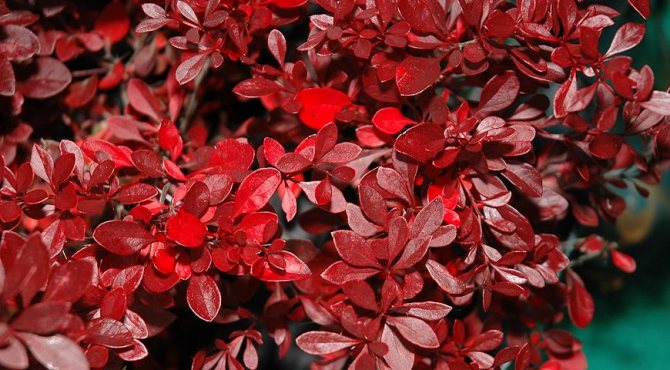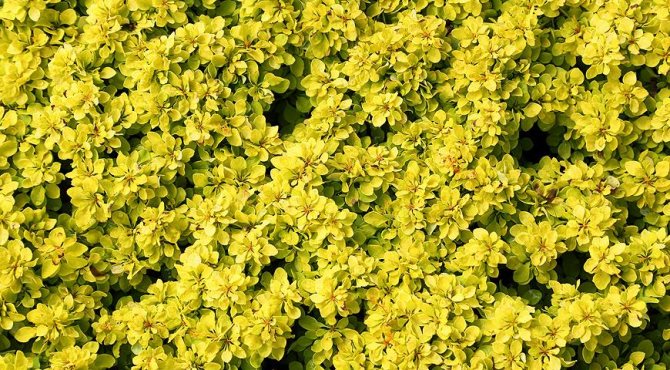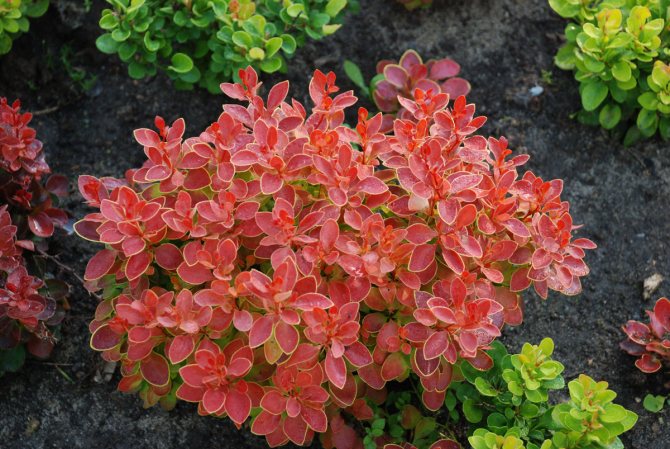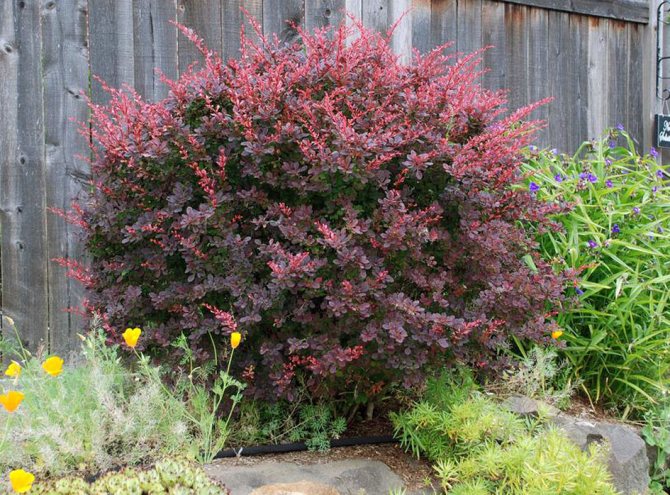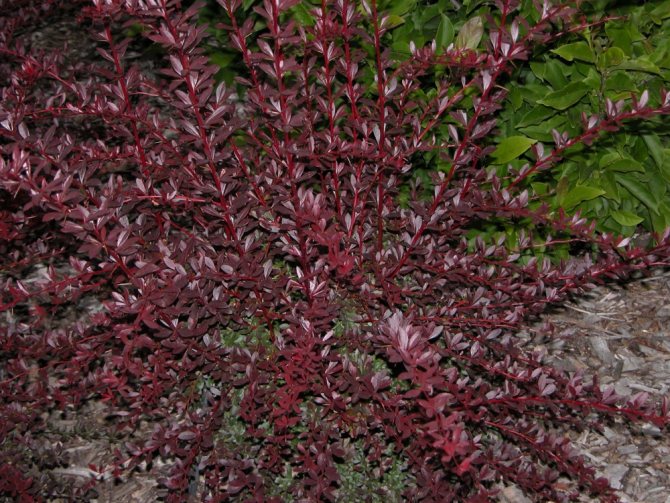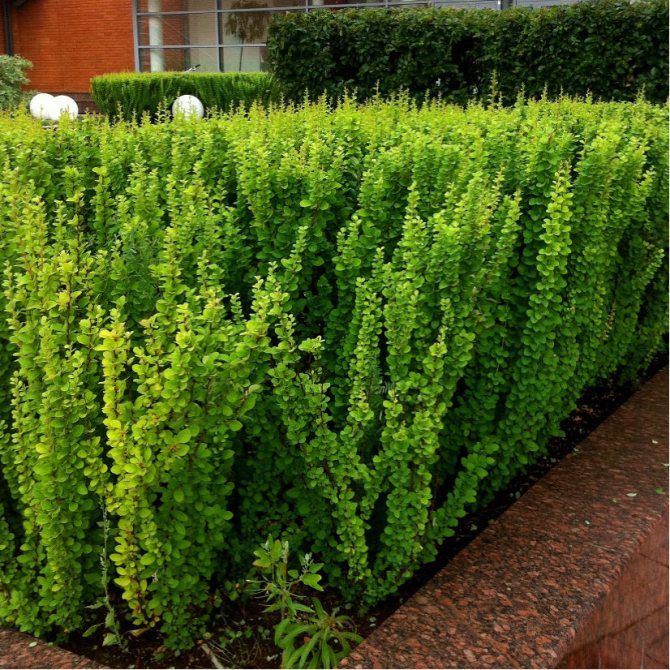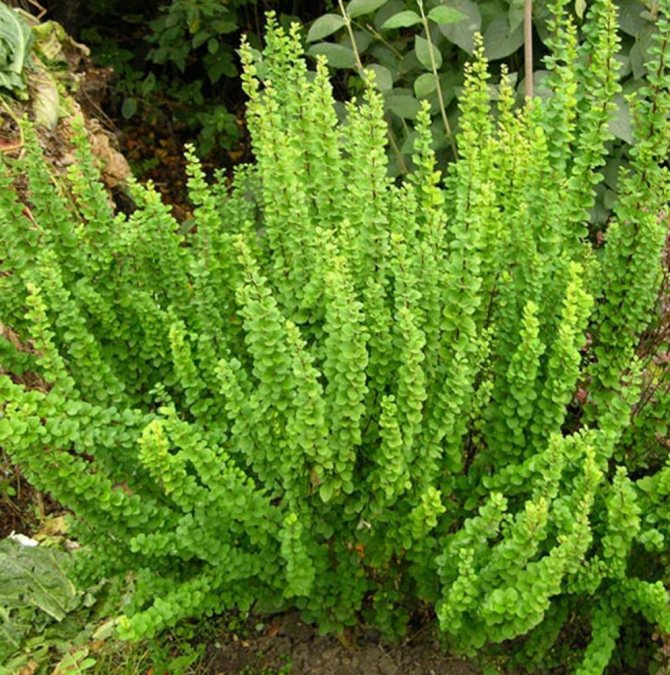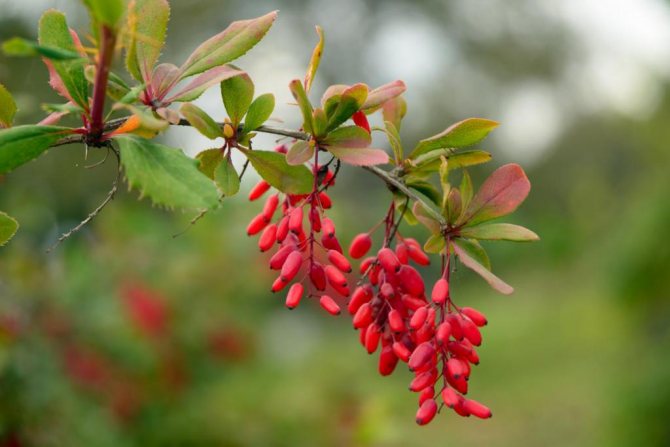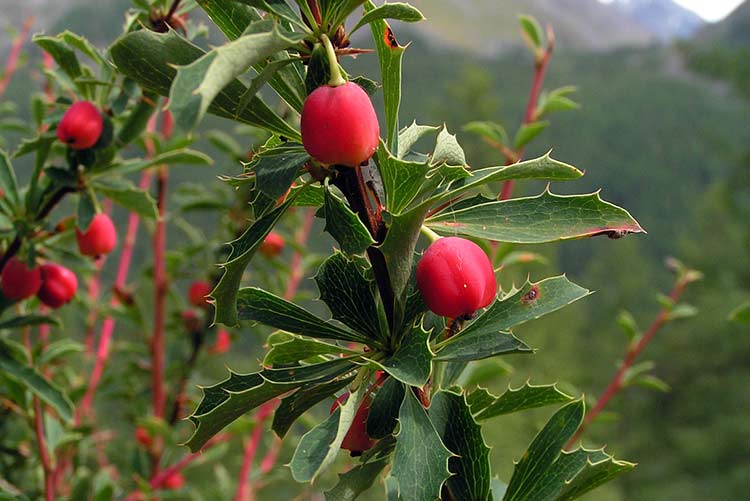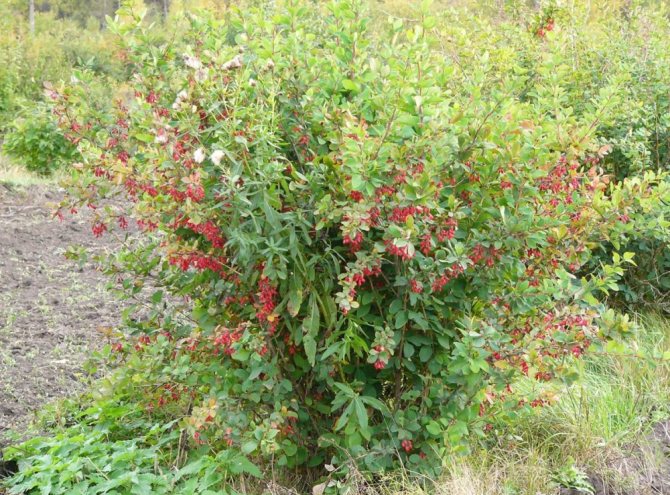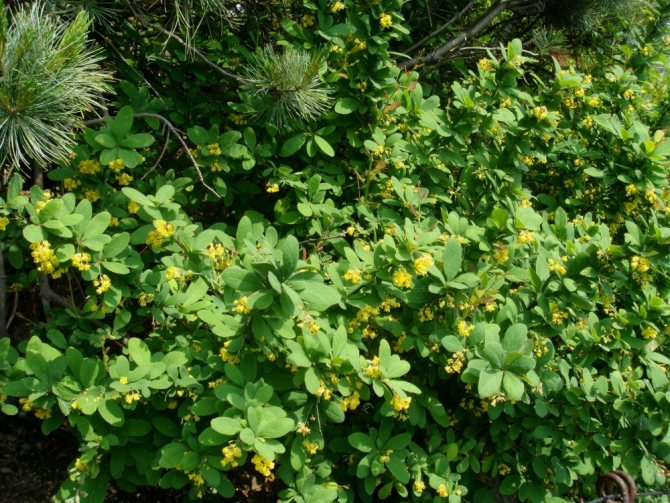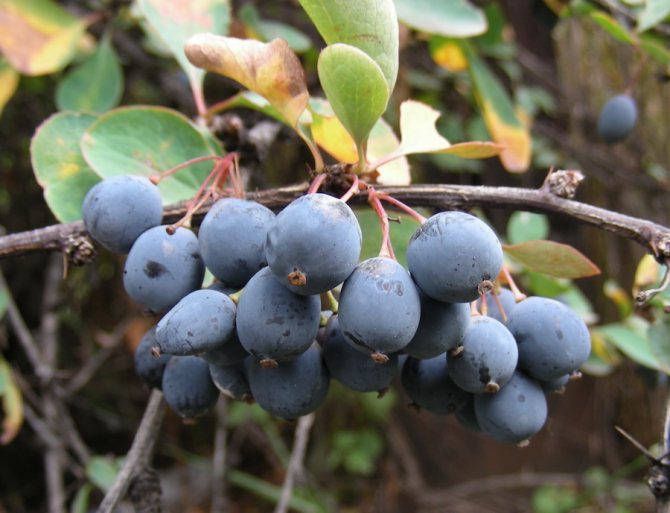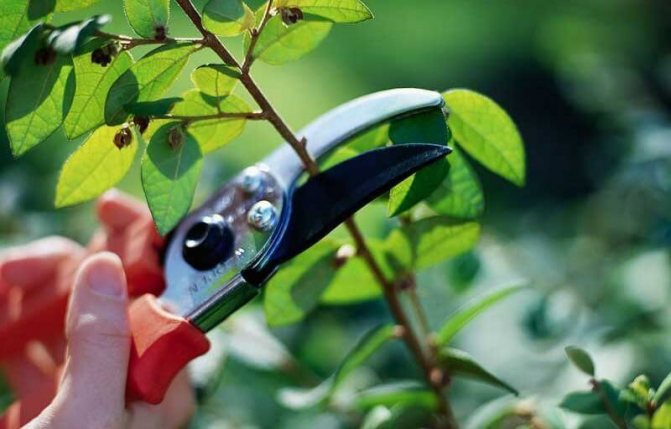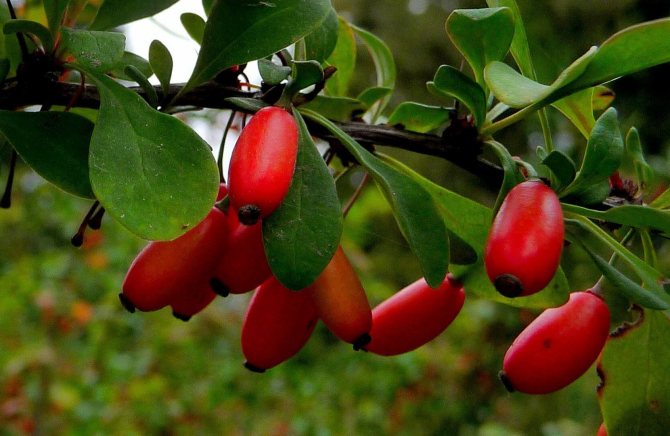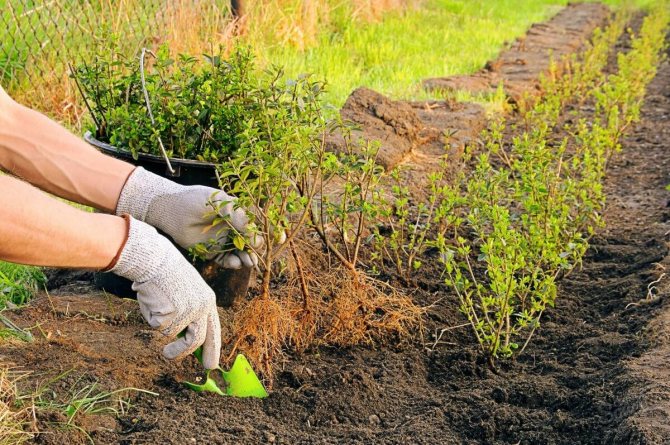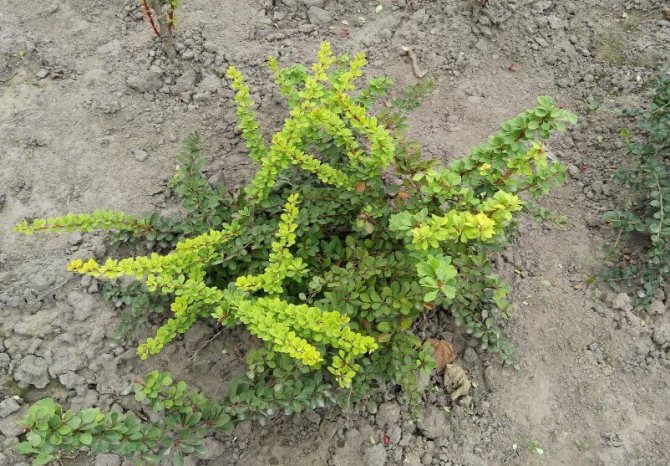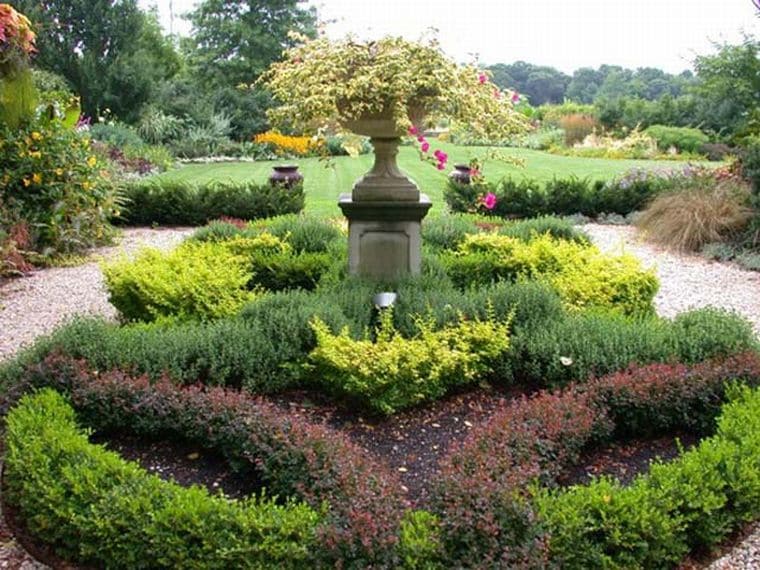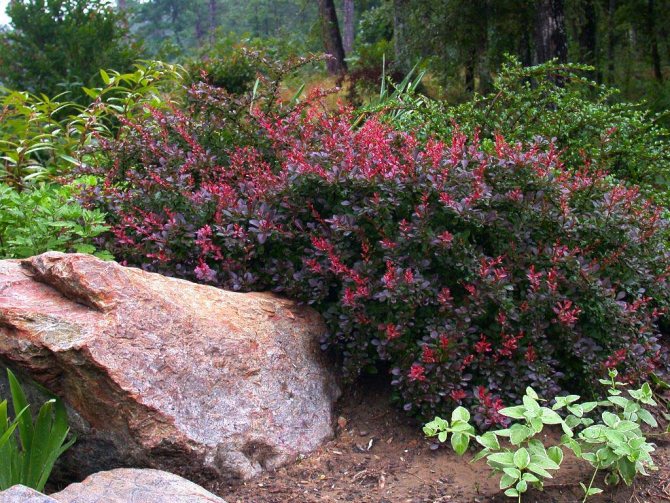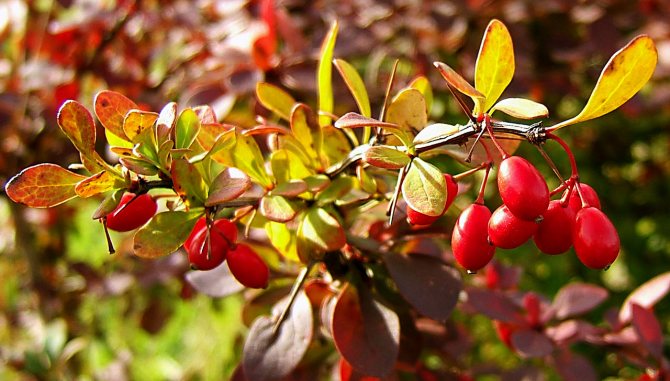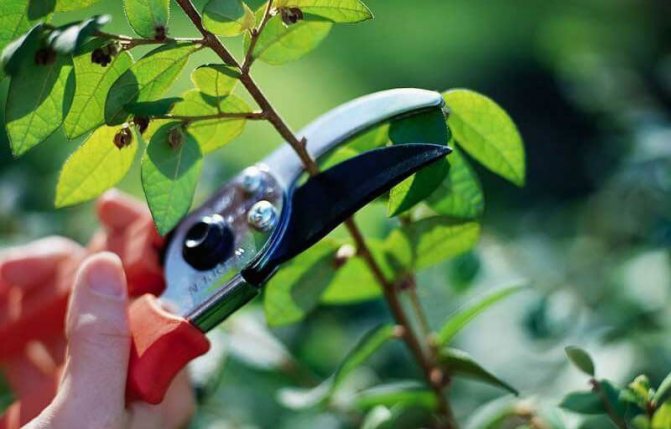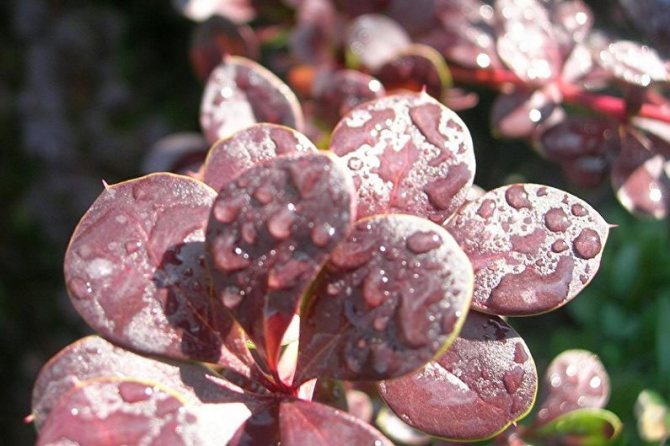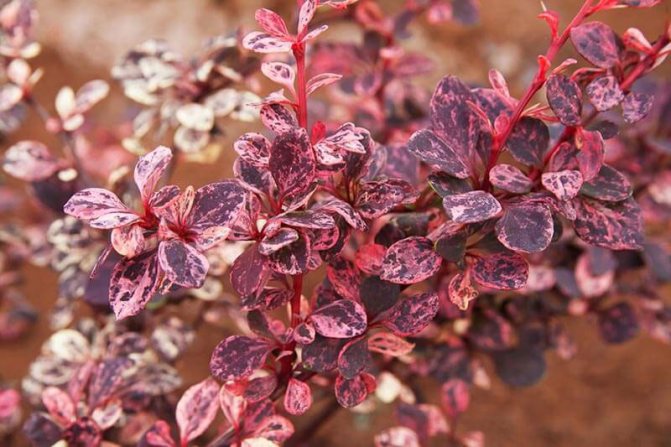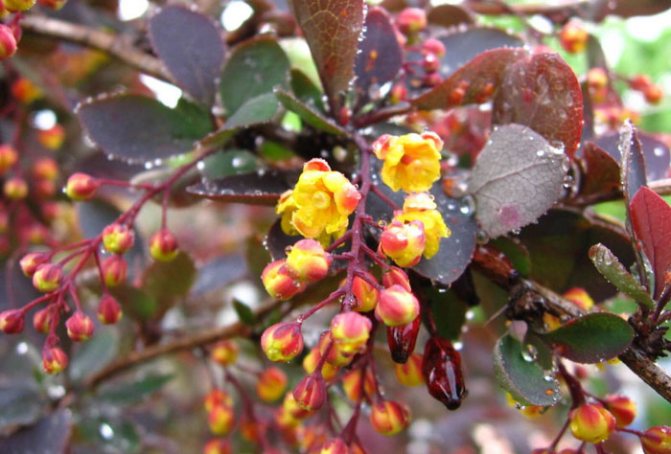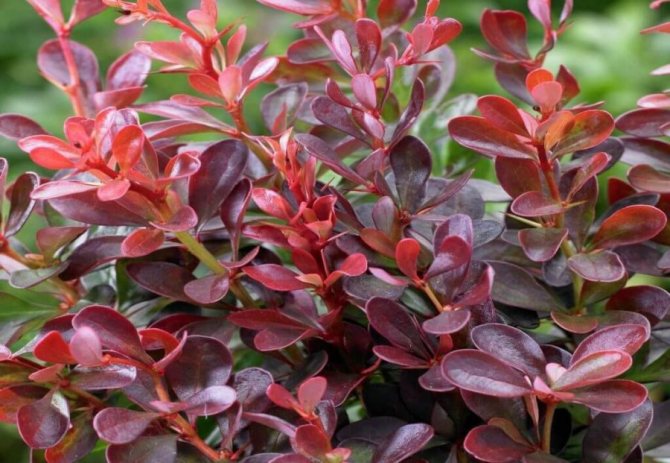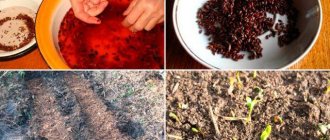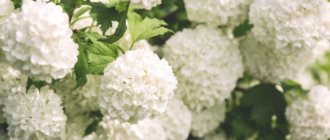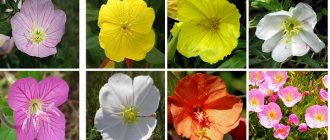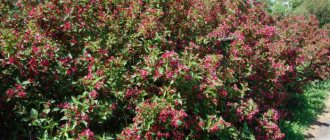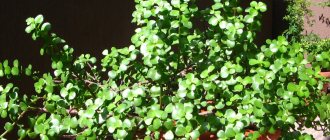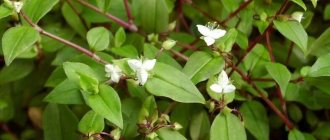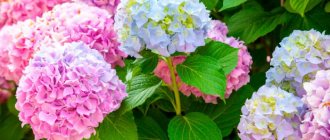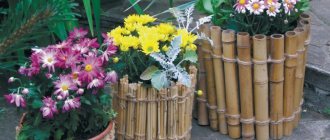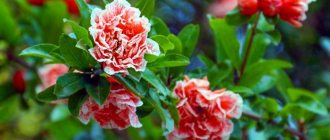Stylish rock garden, exquisite hedge or fancy decorative forms on the site are obtained in the process of cultivating shrubs. Common barberry is distinguished by its all-season beauty: in spring it pleases with green leaves and yellow flowers, and in autumn - with spectacular red berries that can be eaten. For planting a single shrub, seedlings are used, but large-scale cultivation of barberry provides for obtaining material in more affordable ways.
Botanical description
Today, there are more than 170 species of barberry shrubs in the world, planting and caring for which will not be difficult even for a novice gardener. Some plants are semi-evergreen creeping shrubs, others are evergreen, and still others are deciduous. The leaves of the shrub can be alternate, simple or leathery. By the way, few people know, but barberry spines are also leaves, but in a modified form, consisting of one vein, pointed at the end. Below is a photo of a barberry bush grown in Russia.
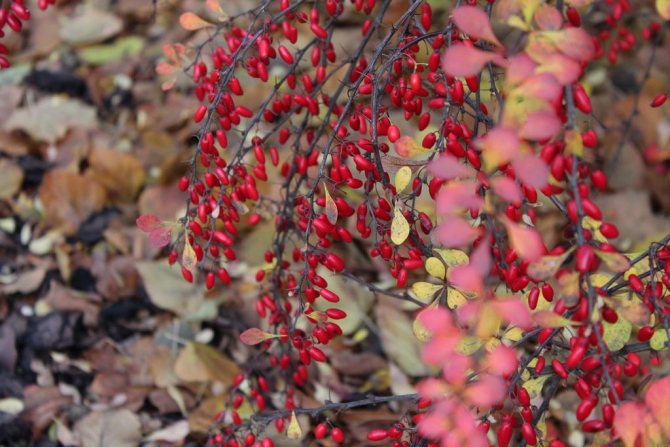
The yellow-golden or orange-red flowers of the barberry have a small size, but a rather fragrant aroma. In most cases, they are collected in corymbose or racemose inflorescences, but they can also be single. The plant is an excellent honey plant, which attracts bees from all over the area to it. Depending on which variety is used for cultivation, the fruits will differ in color and shape. However, they all have a lot of useful properties, since they contain a large number of trace elements and vitamins. Because of this feature, the fruits of the barberry bush, the photo of which is given above, are widely used in traditional and folk medicine. Preparations based on these berries help to get rid of many diseases.
Types and varieties of common barberry
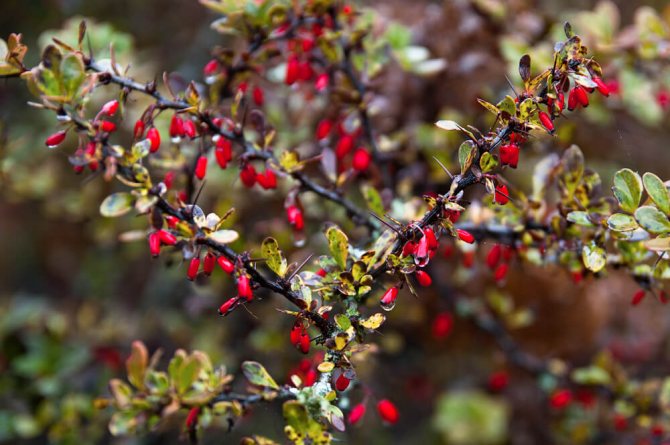

The variety of varieties of barberry allows the summer resident to choose exactly the one that will satisfy his needs. The plant is represented by several species, which in turn include a variety of varieties.
Common barberry
The most extensive group and the most widespread type of barberry. It grows in the south of Russia, settles along forest edges, forest-steppe, hilly areas and in the Caucasus mountains. Sprawling shrub, not exceeding three meters, is protected by thorns. The shoots of the bush are arched, prone to lodging. The foliage of the common barberry is green and red, round-oval in shape, located on short petioles. In the spring, the shrub blooms with yellow small inflorescences, and in the fall, bright and noticeable fruits appear, suitable for consumption.
Barberry Thunberg
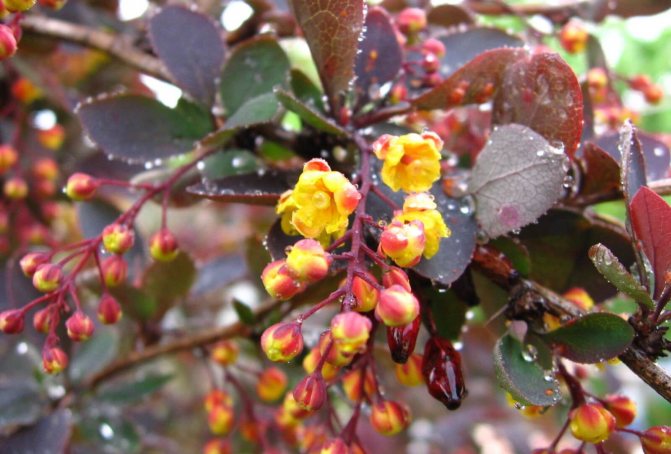

Another common type of barberry, combining a huge number of varieties. The Thunberg bush is popular with gardeners, for its decorativeness and unpretentiousness. The plant is a medium-sized shrub about two to three meters high. A sturdy plant needs to be pruned due to the large amount of overgrowth. The trunk and branches are covered with thorns and over time change color from burgundy to brown, the shrub looks spectacular as part of a hedge.The foliage of the barberry has a different shape and color, most often the form of a pointed oval of burgundy or green, located on short petioles, the leaves do not reach large sizes (average size 4x2 cm).
Inflorescences of Thunberg barberry can be single or racemose, flowers appear in mid-May, giving bright fruits in autumn. Summer residents note some of the most notable varieties of Thunberg:
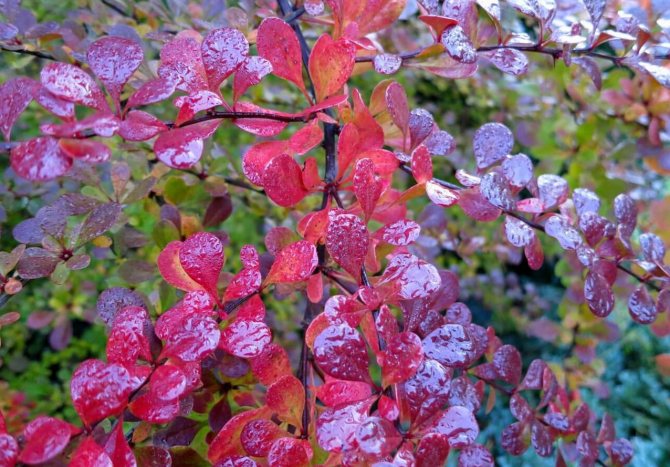

Barberry red Red Pilar, ornamental plant, low bush with attractive, lush forms. Lilac foliage, with burgundy and gray tints.
Barberry variety yellow Golden Ring, a medium-sized bush of about three meters, with a lush cap. The foliage is purple with a red tint and yellow border. The flowering is abundant, bright, begins in the spring, and the barberry berries can be harvested in the fall.
Orange Rocket, an orange variety of barberry, an ornamental shrub with bright foliage and abundant fruiting. The hue of the leaves ranges from bright red to orange. The berries are deep coral in color, elongated and sour-tart on the palate.
Ottawa hybrid species
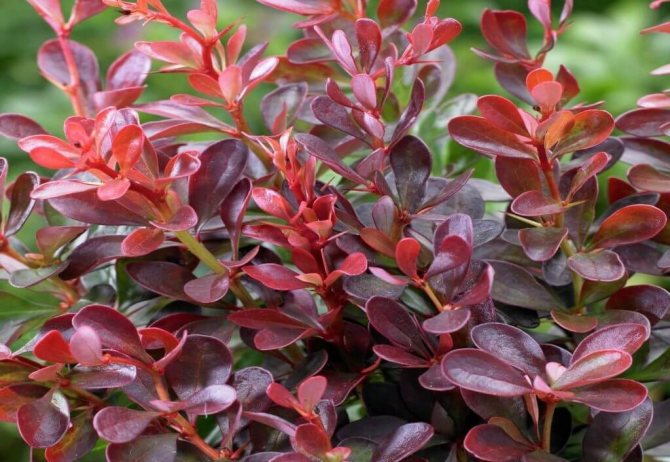

Obtained by crossing barberry Atropurpureya and Thunberg.
It has an exclusively decorative purpose and is similar to the Thunberg barberry. Leaf colors come in magenta, violet, and muddy pink. The plant develops rapidly, is stable and unpretentious. Needs pruning and sunlight. In autumn, the bright burgundy bush of the Ottawa barberry looks advantageous against the gloomy gray background of the garden. The varieties preferred by summer residents: Superba, Auricoma, Silver Miles, these representatives of the species have a bright appearance and are unpretentious in care.
Barberry ordinary purple Anthropurpurea or red-leaved
The bush is lush, spreading, up to two meters high, very popular among summer residents. Anthropurpurea has burgundy or purple leaves, blooms with orange inflorescences, giving bright, large, shiny berries.
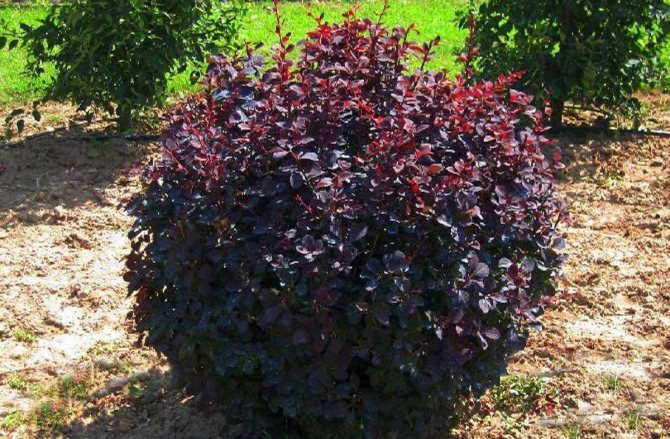

The purple look also has a variegated barberry shape Albovariegata, which differs from anthropurpurea in a more squat shape, and green foliage in white stains and veins.
Aureomarginate with variegated leaves framed by a bronze border, is another form of anthropurpurea. This species is picky about the presence of sunlight, in the shade the bright color of the foliage fades, and the bush begins to stretch upward, losing its "splendor".
Serrata, another form of purple barberry, has serrated leaves.
Sulcata, long, ribbed shoots, Lutea, yellow fruits, Macrocarpa bears fruit well, Alba gives white berries, while y Asperms berries have no pits.
Amur barberry bush
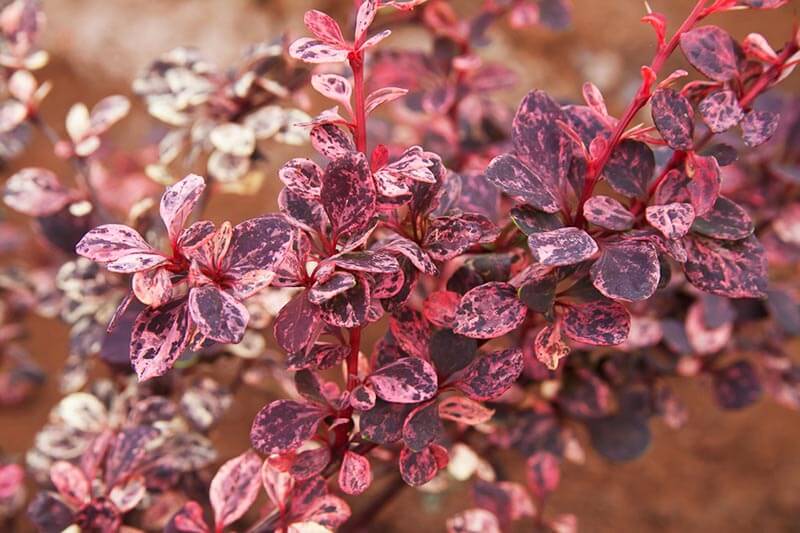

Sprawling, lush, deciduous plant. Primorye is considered the birthplace of growth. Externally, the Amurskys are similar to the Ordinary, it is a large, high (up to three meters), thorny barberry bush, with wide, jagged leaves. Spring green color, Amursky is replaced by an autumn shade of a blazing, scarlet color. This species is unpretentious, resistant to low temperatures, grows well on any soil. Propagation by cuttings and layering always brings good results. The Amur species of barberry, due to its stature, is perfect for the construction of a hedge on the site.
Red barberry Cabernet
A low bush, less than a meter in height, thorns reliably protect the plant from uninvited "guests". Foliage closer to autumn changes color from red to maroon or fiery orange.
It blooms mainly in spring and bears fruit in autumn. Flowers are yellow, small. The berries are crimson red. The plant prefers sunny places with good moisture.
Needs pruning and does not tolerate drought well.
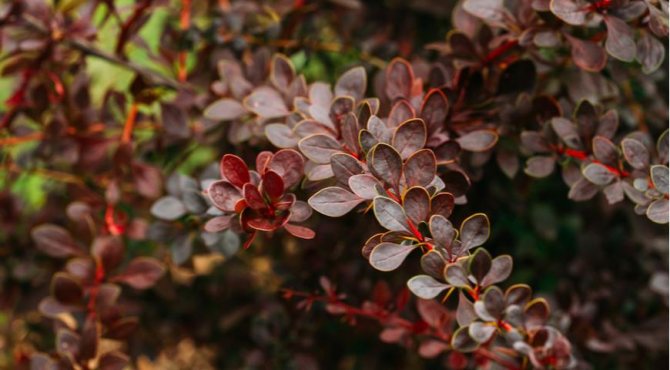

Variegated Barberry Harlequin
The plant grows slowly, tolerates low temperatures capriciously.
Leaves are variegated with white spots.Shoots are covered with small thorns. Flowering starts from May to June. Flowers, small, light yellow, are located throughout the shoot. Harlequin does not tolerate acidic soils and waterlogs.
Planting barberry
The shrub can grow in almost any soil. The plant tolerates drought well and is easy to care for. It can be planted both in partial shade and in open areas that are blown by the wind from all directions. It is preferable to plant the crop in soils with a neutral acid balance, but this is not essential.
Thinking about what a barberry tree with berries looks like? In our article you can find a lot of photos taken in real conditions.
The seedlings are purchased in the spring, right after the snow melts. However, it is worth buying a culture before bud break. Planting is carried out in the spring season, as soon as the deciduous period ends.
During planting, it is necessary to prepare a special pit, into which 10 kg of humus or compost is added, as well as about 100 g of superphosphate, 200 g of ash and 400 g of a lime mixture. All this mixture is covered with fertile soil, after which shrubs are planted in the pit. The distance between adjacent specimens should be approximately 1.5 meters. In most cases, summer residents use a barberry bush to make hedges. In this case, the plants must be planted a little denser.
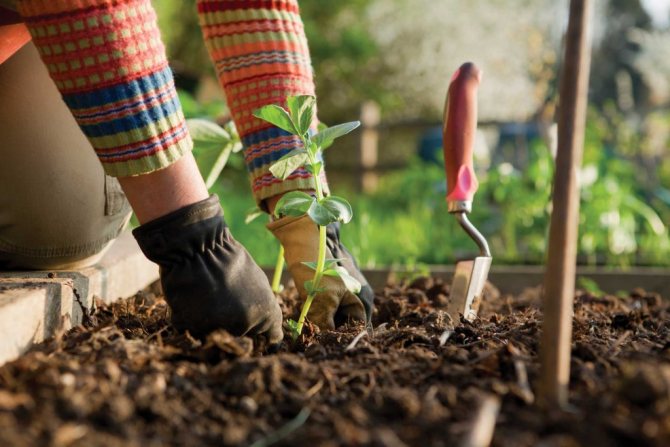

Planting holes are recommended to be prepared several weeks before planting. Their depth should not exceed 40 cm. During the same period, a small layer of sand is added to them in order to ensure good aeration of the roots.
As soon as planting work is completed, all plants are watered abundantly with water. After that, it is necessary to mulch the trunk circle with peat or compost in order to protect the shrubs from freezing.
Composition and calorie content of berries
The main benefit of barberry lies in its fruits - they are enriched with macro - and microelements, vitamins, minerals and acids. For example, in terms of vitamin C content, barberry berries are significantly superior to apples and even lemons.
Almost all plant components contain alkaloids. Columbamine and palmitin, berbamine, as well as berberubin, jatrorricin and oxyacanthin are found in the root bark of barberry, while carotene, vitamin E and phenol carboxylic acids are found in the leaves.
The fruits of barberry contain malic, citric, tartaric and other organic acids, as well as coloring, tannins and pectin substances; the content of glucose and fructose is not more than 5%.
Nutritional value of barberry per 100 grams is about 29.6 Kcal.
Macronutrients:
- Water - from 71 to 73 g
- Protein - 1.6 g (in some types up to 4.5 g)
- Fat - 0.4 g (in some types up to 4.7 g)
- Carbohydrates - from 3.5 to 7.9 g, including ash - from 0.9 to 2.2 g
- Dietary fiber (fiber) - 2.8 g
- The content of organic acids is about 0.96 g
Vitamins:
- B1 (thiamine) - 0.07 mg
- B2 (riboflavin) - 0.15 mg
- B5 (pantothenic acid) - 0.31 mg
- B6 (pyridoxine) - 0.2 mg
- C (ascorbic acid) - from 28.5 to 172 mg
- E (tocopherol) - 4.2 mg
- R (rutin) - 250 to 500 mg
Minerals:
- Potassium - no more than 267 mg
- Sodium - up to 110 mg
- Magnesium - 9 mg
- Calcium - 45 mg
- Iron - 26 mg
- Iodine - 0.16 mcg
- Zinc - 28 mcg
- Cobalt and Lead - 0.72 mcg
- Chromium, Selenium and Molybdenum - 0.40 mcg
- Copper - 14.5 mcg
- Aluminum - 60.4 mcg
- Manganese - 47 mcg
- Strontium - 2.31 mcg
- Boron - 67.6 mcg
- Barium - 8.07 mcg
- Nickel - 2.89 mcg
Care
The barberry shrub is one of the most unpretentious plants, however, in order for the plant to show itself in all its glory, it is necessary to take care of the green pet. The basic rules of care include timely fertilization, weeding, loosening the soil, high-quality watering, and so on.Particular attention should be paid to the correct pruning of shrubs, because this is what most affects the decorative appearance of the barberry.
Watering is recommended at least once a week. For this, well-settled water is used. However, in the rainy season, one should be wary of weekly soil moisture, since excessive moisture in the substrate will lead the plant to death much faster than a prolonged drought. If the plant is affected by root rot, then it will no longer be cured.
The fertilizers applied during planting should be enough for young seedlings for about one year. Immediately after this period, at the beginning of the season, it is necessary to feed each barberry bush with a urea solution at the rate of 30 grams of fertilizer per 10 liters of water. This amount of nitrogen should be enough for the plants for about the next 3 years. At the end of each season, at the end of autumn, the shrubs are fed with phosphorus (15 grams of superphosphate per 10 liters of water) and potash (10 grams per 10 liters) fertilizers.
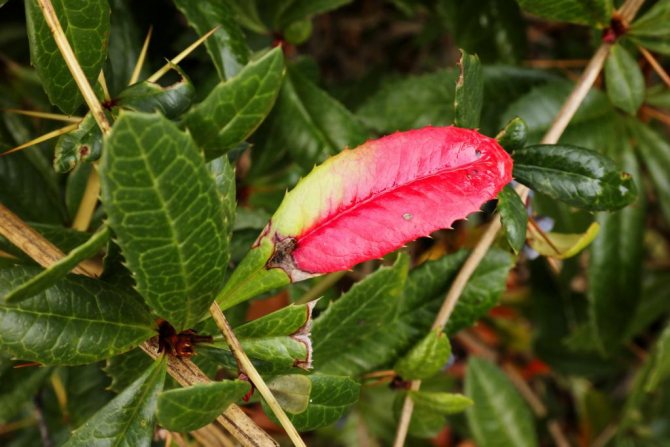

Pruning every year is not necessary, but doing so will give the plants a more lush appearance. For the first time, this procedure is carried out in the first spring after planting. After that, shrubs should only be cut during the summer season, for example, at the end of August or at the beginning of June. However, for low-growing varieties, such procedures are optional.
With the onset of autumn, it is necessary to mulch under the trunk circles. To do this, you can use peat, compost, or even dry leaves. The material can be prepared with your own hands. However, if you decide to mulch with leaves, then collect only well-dried material. At the end of November, a mound is made around each shrub.
In the cold regions of Russia, during the first five years after planting the barberry, it is recommended to cover the plants with branches of spruce branches or to build more serious shelters from scrap materials around the bushes. The easiest way would be to make a small wooden frame and cover it with a thick film. This will help protect the shrub from cold drafts and strong frosts.
Features of the
The name in Latin - Berberis vulgaris, comes from the Arabic word "beri" - a shell, whose shape resembles the leaves of a bush.
Any type of soil is suitable for growing, since the plant is not particularly picky, it gives a crop, even if planted in an area that is not of high quality.
Possesses increased resistance to hot weather conditions, therefore it grows in zones where a warm climate prevails. There is a large amount on the trunks and shoots, due to which the balance of water resource costs is maintained. In this situation, moisture is absorbed slowly, which minimizes the likelihood of drying out.
Distributed in the territories of almost all European countries, it grows in Central Asia, North America, also in the Crimea and the Caucasus, which, according to scientists, are considered the birthplace of culture.
Often used to decorate parks, gardens, and so on. The sprout of common barberry grows so much that it is sometimes difficult to distinguish it from the “Amur” one found in the Far East, where high air temperatures are characteristic. A feature of the wild analog is the ability to grow on poor soils, rocky embankments along the banks of water bodies.
Pests and diseases
Most ornamental trees and barberry shrubs are susceptible to attacks from various insects and diseases. Barberry aphid, barberry sawfly, flower moth are just the main pests that can cause damage to the plant. For insect control, it is recommended to use any insecticidal agent, for example, "Aktara" or "Vertimek".
Among the most characteristic diseases of barberry, various fungal formations are distinguished - rust, powdery mildew, spotting, bacteriosis, and so on. You can fight them both with folk remedies and modern fungicides.
Growing barberry from seeds
Is it possible to grow a barberry tree from a seed at home? Our answer is yes, you can. However, this will not be so easy. But if you fulfill all the requirements, according to the instructions below, then you will be able to grow a full-fledged seedling, from which a large tree will eventually grow out. Thinking about what a barberry bush looks like? Here is the original photo of this plant.
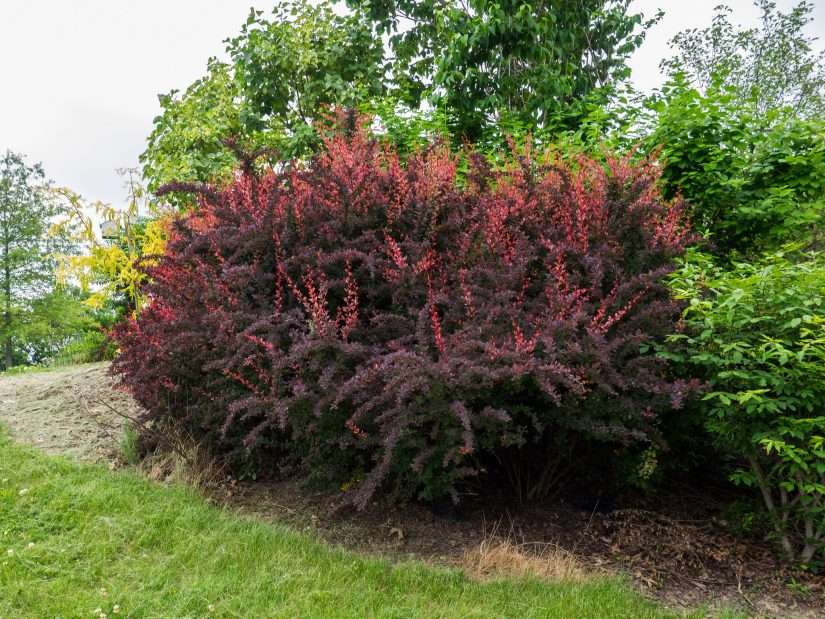

First you need to choose a few of the most ripe berries. Separate the seeds from the pulp, and then rinse them in cold running water. Then you need to disinfect the planting material. For this purpose, you can use a weak solution of potassium permanganate. We leave the seeds in it for 20 minutes, after which we rinse again under running water and dry thoroughly.
The seeds can be planted immediately in loose soil, but it is best to grow the seedlings in plastic cups. As a substrate for planting, it is recommended to use a universal soil with a neutral reaction. The first seedlings can hatch in a month, but it should be borne in mind that the percentage of germination in barberry is extremely small, so plant several copies at once.
After the first shoots appear, it is recommended to grow them for some time at home. If you do not have this opportunity, you can immediately plant the seedlings in the ground. However, this is best done in mid-spring, when night frosts are not expected. The first fruits on the seedlings will appear only after two years, so this is not the best way to reproduce. And about which method is considered more effective, read on.
Cooking use
Common barberry is known for its valuable nutritional qualities, due to which it is actively used in cooking. Ripe berries are good both fresh and dried. By the way, the young foliage of the plant is used for food. It is used in salads and soups. Barberry berries can be added to meat dishes. Juices, drinks, marmalade are prepared from the fruits, syrups, preserves, marshmallows and mousse are boiled. Berries can be pickled and pickled.
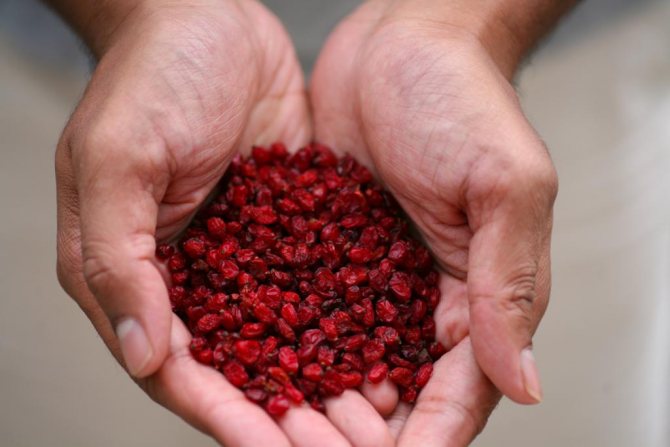

Barberry bushes are excellent honey plants. Barberry honey has a pleasant aroma and a delicate sweet taste. The nectar has a golden yellow color.
Reproduction of culture
Care and planting of a barberry shrub is not difficult. What about breeding? In addition to the seed method, young seedlings can be obtained by other methods. Moreover, this will be done much faster and more conveniently. The main benefits of vegetative propagation are as follows:
- the varietal properties of the parent plant are fully preserved;
- the seedling does not require grafting;
- the finished plant is obtained within one year.
So what is the best way to propagate a barberry shrub in the country?
Cuttings
This method of vegetative propagation allows you to get a fairly large amount of planting material within one year. However, it is worth noting that without heteroauxin or another growth stimulant, root formation on young cuttings will be much slower. This is what this method is:
- At the beginning of summer, we start harvesting planting material. To do this, we cut the lateral annual branches into cuttings, each of which should not exceed 15 centimeters in length.
- All leaves from the bottom of the branch are carefully removed, after which they are treated with growth stimulants according to the instructions on the package for the preparation.
- After the formation of the root system, we plant the cuttings in cups with a pre-prepared mixture of humus, peat, fertile soil and river sand in the ratio: 2: 2: 2: 1.
- We install a film covering on containers with cuttings, thereby creating a greenhouse effect.
- During the entire rooting process, it is necessary to constantly ventilate the greenhouse and regularly spray the cuttings with warm water. If necessary, the earth should be shed and loosened.
- If the cuttings are stored outdoors, be sure to take care of sheltering them for the winter.
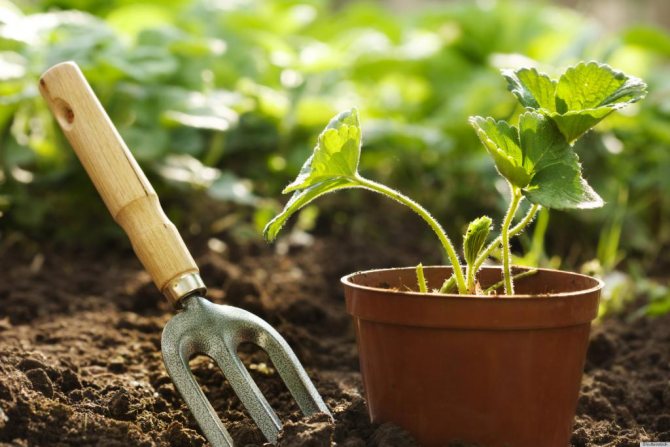

After winter hardening, the seedlings can be planted to a permanent "place of residence" by analogy with the technique described in our article earlier.
Layers
As one of the layers, you can take the lower part of the bush, namely the one-year branch. What is the point of reproduction in this way?
- To begin with, we dig small grooves in the ground, about 15-20 centimeters each. Then we bend the branch to the ground and put it in this hole.
- You can fix the position of the layering using a flyer branch or a wire arc. As a last resort, you can simply tie it to a peg.
- We fill the groove with earth so that only the tip of the young shoot remains above the surface.
Layers do not require any specific care, except for regular watering. If you have prepared young shoots in the spring, then by the fall they will be ready for transplantation. We just dig out the cuttings from the ground in such a way as not to damage the developed root system.
Cultivation
Often, the shrub is used for decorative purposes, since its natural beauty allows you to aesthetically transform the land plot of each summer resident. The plant does not cause much trouble, it grows well when exposed to sunlight, and it is also comfortable to be in the shade.
Annual fruiting is ensured both on fertile and on sandy-clay soil.
The different parts of the green barberry can be used as a base for the plant to spread. In the summer, a stalk that has appeared on a mature shrub is cut off, after which it is buried in the ground. Reproduction is carried out with the help of adventitious buds developing in the primary educational tissue of the root or by dividing the bush. The second option is ineffective when the prototype loses 1/3 of the root.
Dividing the bush
If you have in mind an ornamental barberry shrub that suits you in all respects, then you can try to propagate this plant by dividing the bush. The most suitable time of the year for this procedure is early spring, when young buds have not yet had time to open after hibernation.
- Carefully dig up the mother bush.
- We cut it into several parts. There can be some problems with splitting the roots, so feel free to use a hacksaw.
- We prepare holes about 40 centimeters deep, after which we plant all parts of the bush in them.
- After that, all that remains is to properly cut the plants in order to balance its ground part with the roots. This will improve the survival of the separated parts.
Subsequent care for barberry is no different from caring for an adult plant.
Rejuvenation of old bushes
If there are several old barberry bushes on your site that have a nondescript appearance, then do not rush to completely get rid of the culture, because you have the opportunity to rejuvenate the bush, giving it its former decorative qualities.
You probably already guessed that for this procedure you will need to cut off all the old branches, allowing the new branches to absorb more life-giving moisture. The main thing to remember is that the fruits and flowers of the plant are formed mainly on annual growths, so do not hesitate to remove those branches that were formed a year ago or more.It is also worth noting that with a strong shortening of the branches, the yield of barberry noticeably decreases, so this technique is best used for the decorative forms of this shrub.
What needs to be done to rejuvenate fruit forms? To do this, you will either need to transfer the growth of the bush to a branch by cutting off the central shoots, or completely cut out the old branch to the base, and in its place begin to form a young one.
Although the shrub is not afraid of pruning and haircuts, you should not get too carried away while shortening the branches, otherwise you risk being left without flowers and, accordingly, without a crop.
Preparing a shrub for winter
With the arrival of autumn, especially in the cold regions of Russia, it is worth starting to think about how best to protect plants from drafts and severe frosts. To do this, you can build special frames from scrap materials, and then cover the plant with foil or burlap. After the first snow, a white "cap" forms over the bushes, which will keep the heat inside.
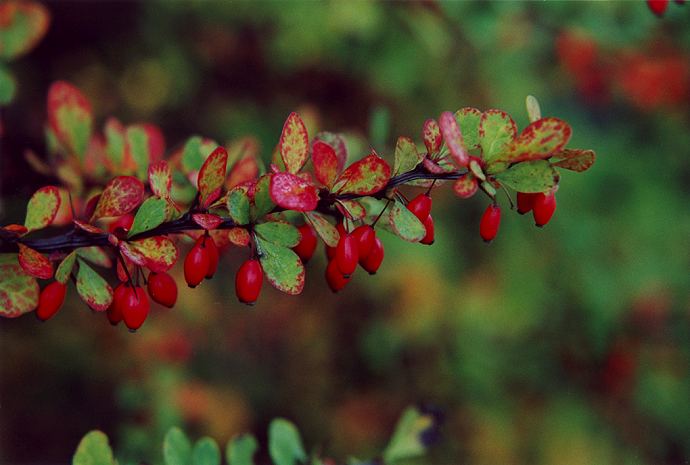

However, before that, it is necessary to perform a number of measures to prepare the barberry for the wintering period:
- We remove various debris (branches, leaves, etc.) from the area around the bushes, after which we dig up the soil with a garden shovel.
- We feed the plants with compost or diluted humus.
- We carry out additional sanitary pruning.
- If necessary, we rejuvenate the bush by removing old shoots.
It is also recommended to carry out additional mulching of the trunks, but in warm regions this is not necessary.
Only young bushes that have not reached the age of five are especially sensitive to winter cold. Therefore, they should first of all be prepared for wintering. For evergreen varieties of barberry, it will be especially important to cover them with spruce branches, which will not only protect the plants from the cold, but also give a decorative look to your site even in the winter season.
Large bushes in front of the shelter must be tied with twine or rope. This will make them more compact, which will significantly reduce the size of the required frame. After installing the trellis box and plants, it is recommended to sprinkle a layer of dry leaves around the perimeter with non-woven material, for example, film or agrofiber. This is done in order to completely exclude the possibility of cold drafts penetrating under the greenhouse.
By the way, it is recommended to insulate most horticultural crops, but you should not rush with this process. It is better to be a little late with the shelter of plants for the winter than to do it too early, especially if you are using an airtight material for insulation. During a thaw, condensation will form under the film, which will surely destroy the bush with the onset of frost. Cold water will gradually drip onto the plants, which will provoke the development of fungal infections.
Growing conditions
The plant is winter-hardy, the heat is not destructive for it, the selected planting area does not affect the yield. An ideal option would be soil with an acidity not exceeding 7.0, and to improve conditions, ground chalk, slaked lime or wood ash are first added to such soil.
Although the barberry is undemanding to the area where it grows, it is still necessary to find a place with deep underground waters. But areas with prolonged seasonal rainfall have a detrimental effect, as too much moisture will not do any good.
Barberry is capable of growing in areas with a poor ecological environment, therefore, even the conditions of megalopolises, which are characterized by increased air pollution with various impurities that negatively affect most plants, are suitable for it.
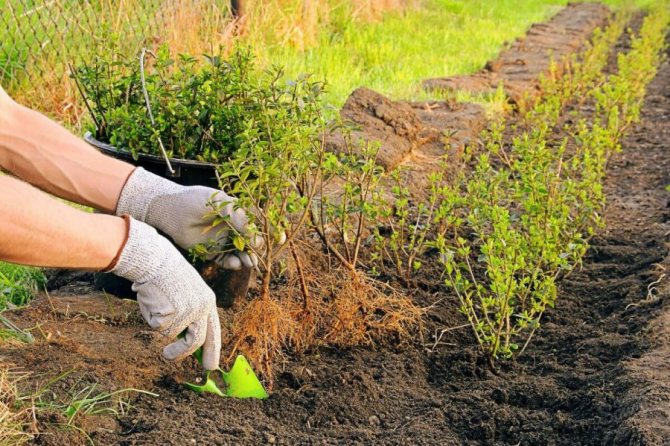

You should choose the side for planting where the sun's rays reach, this will allow you to get a rich harvest
Sanitary pruning
What is this procedure? This is a necessary measure to remove old, dry, broken and diseased branches. It is recommended to hold it annually. When pruning old shoots, you not only give strength for new shoots, but also improve the decorative qualities of the barberry.
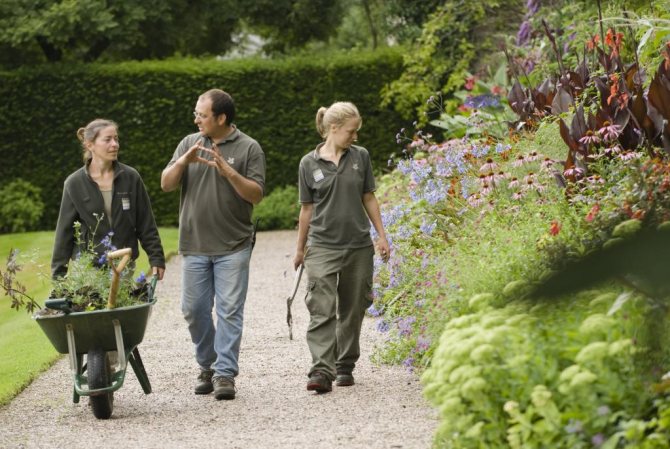

It is worth noting that this type of shrub is practically not susceptible to fungal diseases, so you do not have to worry that due to insufficient ventilation, powdery mildew or apical rot will begin to form inside.
However, this is not a reason not to prune plants at all. If you do not create good ventilation for the barberry, you risk losing part of the crop, which will deteriorate due to lack of sun and excess moisture inside the bush.
We hope our article helped you figure out how to care for barberry at home. Most shrubs are fairly unpretentious plants, but this does not mean that they do not need care. Do not forget to carry out regular sanitization and other preventive measures that will increase the yield and decorative qualities of barberry.

